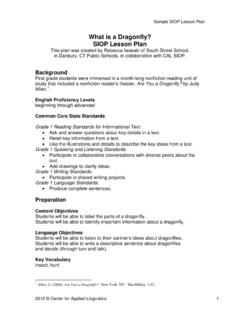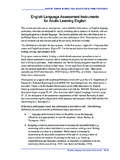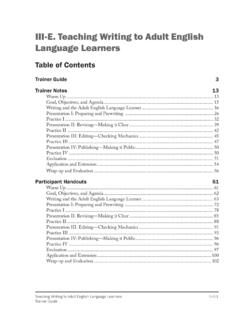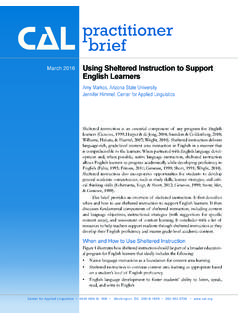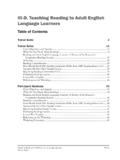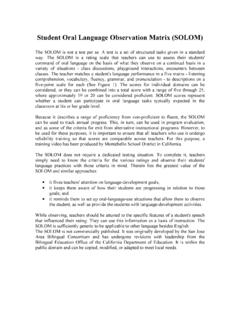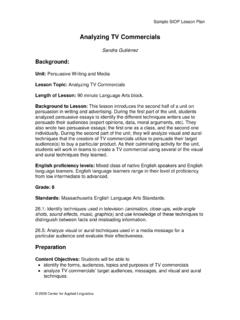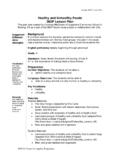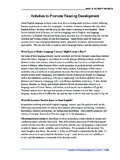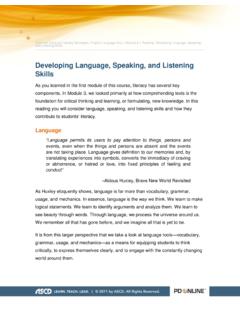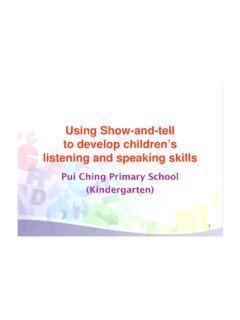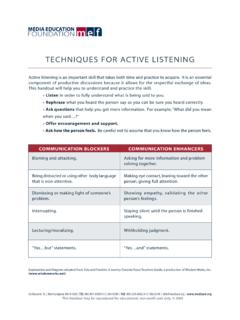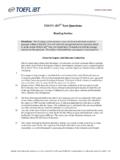Transcription of Listening and Speaking Activities for Adult ESL Learners ...
1 CDE/AEFL, Jane C. Miller 1 Listening and Speaking Activities for Adult ESL Learners Aligned with the BEST Plus Assessment Jane C. Miller Colorado Department of Education Adult Education & Family Literacy Regional Assessment Trainings 2010 CDE/AEFL, Jane C. Miller 2 Introduction Adult ESL Learners have countless daily opportunities for Listening and Speaking in English as they interact as workers, family members, community members, and classroom Learners . Some Listening is non-face-to-face, such as Listening to movies and broadcast media, Listening on the phone, and Listening to loudspeaker announcements.
2 Most Listening , however, combines short bursts of face-to-face Listening interspersed with Speaking such as discussions at the workplace, social conversations with neighbors and colleagues, telephone conversations, and conversations with the many service providers encountered daily doctors, social workers, police officers, store clerks, and school staff. In each context, Learners have a purpose for Listening and a communication task. Listeners may listen to obtain facts or to understand the main idea.
3 They may need to distinguish question words and respond appropriately. They may need to follow or give instructions or advice. Adult Learners may need to distinguish facts from opinions or express their own point of view. They may need to relate what they hear to visual materials they are looking at. They may want to connect with other people by sharing personal stories. Many factors can interfere with Listening and Speaking to create confusions and miscommunications. Misheard sounds and pronunciation errors, inappropriate word choices or wrongly-used grammatical forms can lead to communication breakdowns.
4 Breakdowns can have significant consequences embarrassment, unintended offense, missed appointments, inaccurate processes, etc. ESL teachers have the opportunity to help Adult ESL Learners practice Listening and Speaking in the safe environment of the classroom. Many textbooks contain Listening cassettes or CDs which give Learners the opportunity to hear voices from a variety of speakers engaged in conversations on a variety of life skill topics. In addition, teachers can facilitate Listening and Speaking Activities that utilize pair work and group work.
5 Every Listening / Speaking activity should require a response; the listener should answer a question, follow a direction, choose the correct object from alternatives, write a message, etc. This packet of Listening and Speaking Activities contains just a few of the hundreds of Activities available for classroom instruction. The Activities are organized by the three skills of language scored in the BEST Plus assessment: Listening Comprehension, Language Complexity, and Communication. For each activity the description notes the real world purpose, what the learner will listen for, and what the communication task is.
6 The Activities are not tied to any particular learner proficiency level. Activities are listed in each subsection in a general progression from most simple to most complex. It is assumed that ESL teachers can read the description of an activity and know ways to adapt it, if necessary, to the level of Learners in her classroom. Some Activities are described as whole-class Activities led by the teacher. Many are learner-to-learner pair or group Activities . Most teacher-led Activities are to be read aloud so Learners benefit from the visual clues of facial expression and mouth movement.
7 However, these Activities optionally can be tape recorded to give Learners practice in non-face-to-face Listening . The greatest value of using these Activities is that Listening instruction becomes an intentional focus of classroom instruction. Jane C. Miller ESL Specialist and Professional Development Coordinator Colorado Department of Education, Adult Education and Family Literacy CDE/AEFL, Jane C. Miller 3 List of Activities in Packet Listening Comprehension (LC): Activities to distinguish question words and types (pp.)
8 X-X) LC-1: Answering Simple Questions LC-2: Picture Descriptions LC-3: Class Story Using Language Experience Approach LC-4: It Happened Last Week LC-5: My Favorite Gift 20 Questions LC-6: Interviews LC-7: In the News Listening Comprehension (LC): Activities to develop Listening for details (pp. X-X) LC-8: Minimal Pairs LC-9: Dictation LC-10: Cloze (fill-in) Dictation LC-11: Dialogue Dictation LC-12: Past, Present, Future LC-13: Picture Story Sequence I LC-14: Picture Description That s Not Right!
9 LC-15: Altered Texts and Broadcasts LC-16: Picture Dictations LC-17: Just the Facts LC-18: Maps and Grids Listening Comprehension (LC): Activities to develop Listening to extended speech (pp. X-X) [See also LC-4, LC-9, LC-13, LC-14, LC-15, and LC-16 above] LC-19: News Quips and Questions LC-20: Flyswatter Vocabulary LC-21: What s in the Bag? Listening Comprehension (LC): Activities to develop clarification strategies (pp. X-X) LC-22: I Say, You Say LC-23: Poetry Dictation Language Complexity (LX): Activities to develop vocabulary (pp.)
10 X-X) LX-1: Flashcards and Vocabulary Journal LX-2: Matching/Concentration LX-3: Vocabulary Bingo LX-4: Odd Word Out LX-5: Flyswatter Vocabulary (see LC-20) LX-6: Retelling Language Complexity (LX): Activities to develop sentence complexity (pp. X-X) LX-7: Sentence Word Order CDE/AEFL, Jane C. Miller 4 LX-8: Model Dialogues LX-9: Stating a Preference and Giving Reasons LX-10: Which One in Which Square? LX-11: Expanding Sentences Language Complexity (LX): Activities to develop elaboration (pp.
